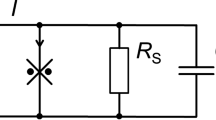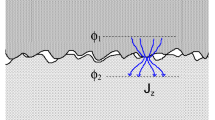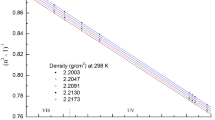Abstract
A generalized formula for electron emission current as a function of temperature, field, and electron work function in a metal–dielectric system has been derived with regard to the quantum nature of image forces. For free electrons, the Fermi–Dirac distribution and a quantum image potential obtained in terms of the electron polaron theory have been used. The well-known Richardson–Schottky formula (for thermionic emission) and Fowler–Nordheim formula (for field emission) have been derived in the limit of the image force classical potential. It has been shown that at high temperatures and electric fields E ≥ 10 MV/cm, the polaron contribution grows with field and declines with rising temperature. The decrease in emission current is associated with the increase in effective work function of electrons, which is due to the electron polaron effect. Extrapolation formulas suitable for theoretical estimation of thermionic and cold emission currents have been obtained.




Similar content being viewed by others
REFERENCES
G. A. Mesyats and D. I. Proskurovsky, Pulsed Electrical Discharge in Vacuum (Springer, Berlin, 1989).
High Voltage Vacuum Insulation: Basic Concepts and Technological Practice, Ed. by R. V. Latham (Academic, London, 1995).
B. M. Cox and W. T. Williams, J. Phys. D: Appl. Phys. 10 (3), L5 (1977).
G. A. Mesyats, Cathode Phenomena in a Vacuum Discharge: The Breakdown, the Spark, and the Arc (Nauka, Moscow, 2000).
A. Anders, Cathodic Arcs: From Fractal Spots to Energetic Condensation (Springer, New York, 2008).
G. Guignard, CERN Report 2000-008 (Geneva, 2000).
W. Wuensch, Tech. Rep. CERN-OPEN-2014-028, CLIC Note-1025 (CERN, Geneva, 2013).
S. A. Barengolts, V. G. Mesyats, V. I. Oreshkin, E. V. Oreshkin, K. V. Khishchenko, I. V. Uimanov, and M. M. Tsventoukh, Phys. Rev. Accel. Beams 21, 061004 (2018).
Yu. D. Korolev and G. A. Mesyats, Physics of Pulsed Breakdown in Gases (URO-press, Yekaterinburg, 1998).
Y. Toyozawa, Progr. Theor. Phys. 12, 421 (1954).
J. Hermanson, Phys. Rev. 6, 2427 (1972).
J. Hermanson, in Elementary Excitations in Solids, Molecules, and Atom, Part B (Springer, 1974), p. 199.
S. I. Beril and E. P. Pokatilov, Semiconductors 12, 1207 (1978).
E. P. Pokatilov, S. I. Beril, and V. M. Fomin, Poverkhn.: Fiz., Khim., Mekh. 5, 5 (1988).
E. P. Pokatilov, S. I. Beril, and V. M. Fomin, Phys. Status Solidi B 147, 163 (1988).
S. I. Beril, E. P. Pokatilov, E. P. Goryachkovskii, and N. N. Semenovskaya, Phys. Status Solidi B 176, 347 (1993).
E. P. Pokatilov, S. I. Beril, and V. M. Fomin, Vibrational Excitations, Polarons, and Excitons in Multilayer Systems and Superlattices (Shtiintsa, Kishinev, 1990), p. 155 [in Russian].
E. I. Murphy and A. N. Good, Phys. Rev. 162, 1464 (1956).
Y. A. Barengolts and S. I. Beril, IEEE Trans. Plasma Sci. 42, 3109 (2014).
Y. A. Barengolts and S. I. Beril, in Proceedings of the 3rd International Conference on Nanotechnologies and Biomedical Engineering, IFMBE Proc. 55, 230 (2016).
K. V. Reich and E. D. Eidelman, Eur. Phys. Lett. 85, 47007 (2009).
V. S. Edel’man, Sov. Phys. Usp. 23, 227 (1980). https://doi.org/10.1070/PU1980v023n04ABEH004711
V. B. Shikin and Yu. P. Monarkha, Fiz. Nizk. Temp. 1, 957 (1975).
A. Modinos, Field, Thermionic, and Secondary Electron Emission Spectroscopy (Plenum, New York, 1984).
A. Harstein and Z. A. Weinberg, Phys. Rev. 20, 1335 (1979).
A. Harstein and Z. A. Weinberg, J. Phys. C: Solid State Phys. 11, L469 (1978).
V. N. Shrednik, in Non-Heated Cathodes (Sovetskoe Radio, Moscow, 1974), p. 166 [in Russian].
E. O. Popov, A. G. Kolosko, M. A. Chumak, and S. V. Filippov, Tech. Phys. 64, 1530 (2019).
Funding
This study was supported by the Russian Foundation for Basic Research, grant no. 17-08-01282.
Author information
Authors and Affiliations
Corresponding author
Ethics declarations
The authors declare that they have no conflicts of interest.
Additional information
Translated by V. Isaakyan
Rights and permissions
About this article
Cite this article
Beril, S.I., Barengolts, S.A., Barengolts, Y.A. et al. A Quantum Theory of Electron Emission from a Metal–Dielectric Structure in High Electric Fields. Tech. Phys. 65, 994–1001 (2020). https://doi.org/10.1134/S1063784220060043
Received:
Revised:
Accepted:
Published:
Issue Date:
DOI: https://doi.org/10.1134/S1063784220060043




